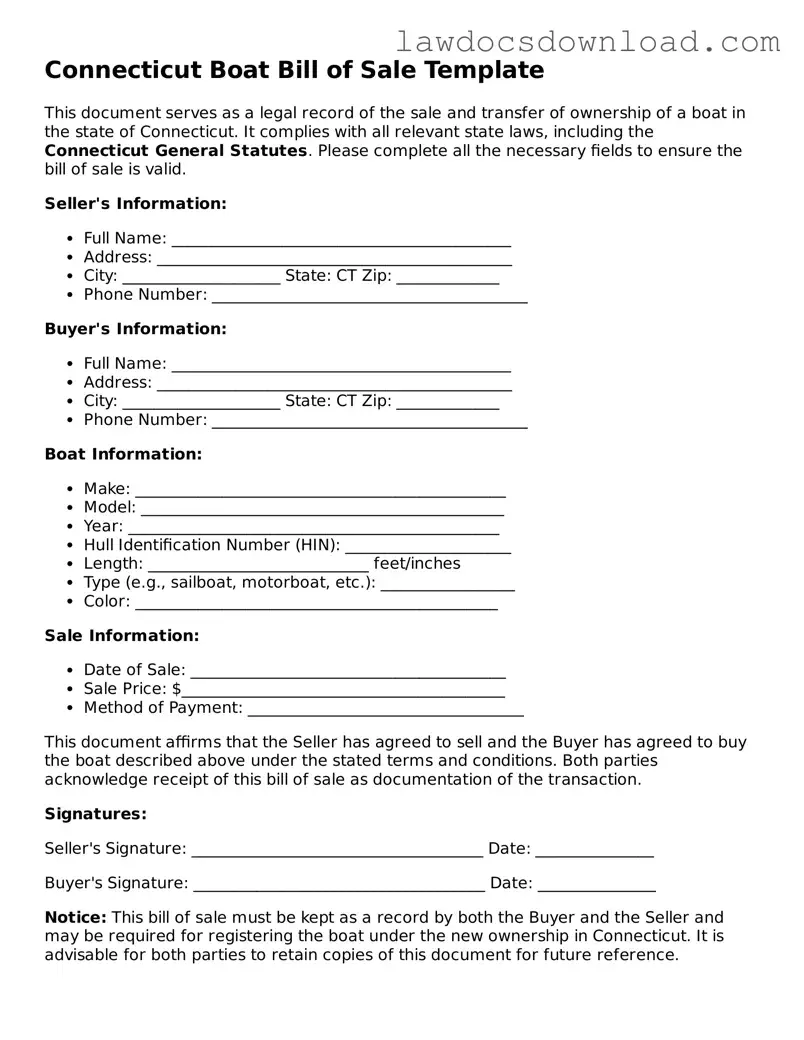A Vehicle Bill of Sale is quite comparable to the Connecticut Boat Bill of Sale in its function and purpose. It serves as a formal document that records the sale and transfer of ownership of a vehicle from one party to another. This document typically includes important details similar to those found in a Boat Bill of Sale, such as the vehicle's make, model, year, VIN (Vehicle Identification Number), and the sale price. Additionally, it indicates the agreement between the seller and the buyer and may be necessary for the registration of the vehicle in the new owner's name.
Another document that shares similarities with the Connecticut Boat Bill of Sale is the General Bill of Sale. This type of bill of sale is used for transactions involving personal property items that do not necessarily fit into categories like vehicles or boats, such as electronics, furniture, or pets. Like the Boat Bill of Sale, it provides a recorded agreement detailing the item sold, the sale price, and the parties involved, thereby serving as a receipt for the transaction and a safeguard against future disputes.
The Aircraft Bill of Sale is also akin to the Boat Bill of Sale, tailored for transactions involving the sale of an airplane or helicopter. This document includes specific information pertinent to aircraft, like the make, model, serial number, and FAA registration number, similar to how the Boat Bill of Sale includes details specific to maritime vessels. It solidifies the change of ownership and is crucial for the legal registration of the new owner with aviation authorities.
For transactions involving the transfer of a firearm from one individual to another, a Firearm Bill of Sale is used, which is analogous to the Boat Bill of Sale. It documents the details of the transaction, including information about the firearm (make, model, and serial number), the sale price, and personal details about the buyer and seller. This document is significant for record-keeping purposes and may be required by state law, similar to the boat bill of sale's importance in boat transactions.
The Horse Bill of Sale, while focusing on the transfer of ownership of equines, parallels the Connecticut Boat Bill of Sale. It contains thorough details about the horse (such as breed, color, and age), the sale amount, and the terms of sale, mimicking the specificity and structure seen in the Boat Bill of Sale. This document is vital to confirm the transaction and to be used as a reference in any potential future disputes or for registration purposes with equine associations.
Last but not least, the Business Bill of Sale is similar to the Connecticut Boat Bill of Sale but is used in the context of selling a business. It outlines the agreement details between the buyer and seller, listing assets being transferred as part of the sale, including physical and intangible assets, like company goodwill, inventory, and equipment. This document ensures that the terms of the sale are clear and agreed upon, offering legal protection for both parties involved, akin to the protective function of the Boat Bill of Sale in boat transactions.
